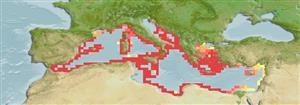Common names from other countries
Classification / Names / Names
Namen | Synonyme | Catalog of Fishes (gen., sp.) | ITIS | CoL | WoRMS
Environment: milieu / climate zone / depth range / distribution range
Ökologie
; tiefenbereich 125 - 200 m (Ref. 2754). Subtropical
Endemic to the Mediterranean Sea.
Length at first maturity / Size / Gewicht / Alter
Maturity: Lm ? range ? - ? cm Max length : 120 cm SHL Männchen/unbestimmt; (Ref. 128053); max. veröff. Alter: 45 Jahre (Ref. 128053)
Life cycle and mating behavior
Geschlechtsreife | Fortpflanzung | Ablaichen | Eier | Fecundity | Larven
Members of the class Bivalvia are mostly gonochoric, some are protandric hermaphrodites. Life cycle: Embryos develop into free-swimming trocophore larvae, succeeded by the bivalve veliger, resembling a miniature clam.
Demir, M. 2003. (Ref. 2754)
IUCN Rote Liste Status (Ref. 130435)
CITES Status (Ref. 108899)
Not Evaluated
Not Evaluated
Nutzung durch Menschen
| FishSource |
Tools
Internet Quellen
Estimates based on models
Preferred temperature
(Ref.
115969): 13.1 - 16.5, mean 14.2 (based on 17 cells).
Widerstandsfähigkeit
mittel, Verdopplung der Population dauert 1,4 - 4,4 Jahre. (K=0.05-0.28; tmax=45).
Preiskategorie
Unknown.
